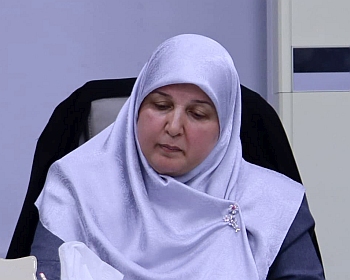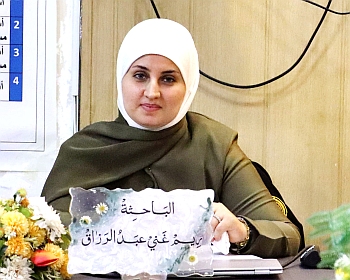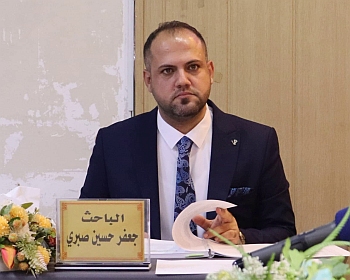ناقش قسم الكيمياء في كلية التربية للعلوم الصرفة ( ابن الهيثم ) رسالة الماجستير الموسومة (تحضير , تنشيط وتشخيص الجاركول النباتي من قشور حبوب دخن بروسو واستعماله لامتزاز صبغة عضوية ) للطالبة ( رسل عبد السلام فرج حمود ) التي انجزتها تحت اشراف التدريسي في القسم ( أ.م.د. احمد محمد عباس ) ونوقشت من قبل لجنة المناقشة التي تألفت من الاعضاء المبينة اسمائهم فيما يأتي :
-
أ.م.د. ضياء هادي حسين (رئيسا)
-
أ.د انتصار عليوي لعيبي (عضوا)
-
أ.م.د. فراس حبيب عبد الرزاق (عضوا)
-
أ.م.د. احمد محمد عباس (عضوا و مشرفا)
وهدفت هذه الدراسة الى استعمال مخلفات نباتية من قشور حبوب نبات الدخن (نوع بروسو) المتوفرة محليا في الاسواق العراقية في انتاج سطوح كاربونية نشطة (AC) وتحميلها بجزيئات الحديد مع معالجة كيميائية بمواد مركزة (بيروكسيد الهيدروجين او الامونيا ) لإنتاج سطوح كاربونية معدلة (ACIPE و ACIAM) .ولأجل التأكد من تحضير السطوح والتغيرات التي طرأت عليها استعمل في تشخيص هذه السطوح المحضرة الثلاثة (ACIAM , ACIPE ,AC) عدد من التقنيات تتضمن تقنية تحويل فورييه للأشعة تحت الحمراء (FT-IR) وانبعاث المجال للمجهر الالكتروني الماسح (FESEM) وتحليل تشتت الطاقة بالأشعة السينية (EDX) وتعيين المساحة السطحية بطريقة (BET), فضلا عن انه تم قياس عدد من الخواص الفيزيائية للسطوح جميعها تتمثل ب ( نسبة الكاربون الثابت ,نسبة الرطوبة, نسبة المواد المتطايرة, ونسبة الرماد ,نسبة المواد الذائبة بالحامض ,نسبة المواد الذائبة بالماء ,حموضة السطوح ,وتعيين نقطة التعادل الشحنة ,والمسامية ) ومن خلال هذه الخواص تم معرفة جودة و فعالية السطوح وامكانية تطبيقها في مجال الامتزاز . لغرض تعيين الظروف المثلى لعملية امتزاز صبغة الكونغو الاحمر (CR) على كلً من السطوح الكاربونية المدروسة وذلك من خلال دراسة تأثير عدة عوامل ( وزن السطح الماز , زمن الاتزان , التركيز الابتدائي للصبغة , درجة الحرارة ) . إذ نلاحظ زيادة كمية المادة الممتزة مع زيادة الزمن وصولا الى مرحلة التوازن والتي يعين عندها زمن الاتزان للصبغة على سطح حيث وجد ان الزمن اللازم للوصول الى حالة الاتزان باستعمال السطح الاول ((AC هو (min45) و كل من السطح الثاني (ACIPE) و السطح الثالث (ACIAM) هو (min60) هذا من جهة ومن جهة ثانية وجد ان كمية الصبغة الممتزة على كل السطوح تزداد مع زيادة درجة الحرارة مما يدل على ان طبيعة عملية الامتزاز تكون ماصة للحرارة ,أجريت دراسة حركية لعملية امتزاز لصبغة الكونغو الاحمر وعند درجات حرارة مختلفة من خلال تطبيق عدد من النماذج الحركية (مرتبة اولى كاذبة ,مرتبة ثانية كاذبة , معادلة ويبر – موريس) , وبينت النتائج اتباعها لنموذج المرتبة الثانية الكاذبة لجميع الانظمة قيد الدراسة وعند جميع درجات الحرارة كما تم حساب طاقة التنشيط لكل نظام حيث كانت اقل من(40 kj/mol)لأنظمة امتزاز صبغة الكونغو الاحمر ولكلا السطحين المازينACIPE) ,( AC مما يبين تفضيل( الامتزاز الفيزيائي) بينما كانت أكبر من (40 kj/mol) لأنظمة امتزاز صبغة الكونغو الاحمر على السطح الماز(ACIAM ) وهذا يدل على أن الانظمة تفضل حدوث ( الامتزاز الكيميائي).
و تمت دراسة توازن الامتزاز بتراكيز ابتدائية مختلفة وعند درجات حرارية مختلفة حيث صنفت انظمة امتزاز صبغة الكونغو الاحمر على كل السطوح من النوع ( S) وفق لتصنيف جيلز والتي تكون فيه امتزاز جزيئات الصبغة الممتزة بصورة (عمودية أو مائلة )على السطح الماز .اختبرت على انظمة الامتزاز عدة نماذج ايزوثيرمات تتضمن (Langmuir ,Temkin, Freundlich, Dubinin-Radushkevich) ومن خلال تطبيق هذه الايزوثيرمات تبين أن أفضل ايزوثيرم لوصف عملية الامتزاز لصبغة ) الكونغو الاحمر) على كل من السطوح (ACIAM,ACIPE,AC) هو ايزوثيرم فرندليش ,بالمحصلة يكون نموذج ايزوثيرم فريندليش الاكثر ملاءمة للأنظمة قيد الدراسة وبشكل أقل منه نموذج تمكن والاقل منة نموذج لانكماير ثم يأتي بعده نموذج دوبنن –رودوشكيفج) .
وكذلك تم حساب الدوال الثرموديناميكية لأنظمة الامتزاز قيد الدراسة , إذ بينت القيم الموجبة للتغير في الانثالبي (˚ΔH) على أن التفاعل ماص للحرارة وبينت القيم الموجبة لطاقة كبس الحرة موجبة والقليلة لكلا السطحين المازيين (ACIAM,AC) مما يدل على عدم تلقائية عملية الامتزاز ولكن هذه القيم تقل مع زيادة درجة الحرارة لتصبح أكثر تلقائية وهذا ما يتطابق مع نتائج الامتزاز للسطحين أما القيم السالبة للسطح (ACIPE) نلاحظ تلقائية وسهولة امتزاز الصبغة على هذا السطح (ACIPE) وكذلك للسطح (ACIAM) عند درجات حرارة عالية أذ تزداد تلقائية حدوث العملية مع زيادة درجة الحرارة وبينت القيم الموجبة للتغير في الانتروبي على الزيادة في العشوائية أما القيم السالبة فبينت النقصان في العشوائية .
preparation , activation and characterization of plant charcoal from proso millet grain husks using for organic dye adsorption
By Rusul Abdul Salam FarajHammoud
Supervised by Asst.prof.Dr. Ahmed Mohammed Abbas
Abstract
This study aimed to use plant residues from the millet grain husks (Proso type) available locally in the Iraqi market in the production of active carbon surfaces (AC) and loaded by iron particles with chemical treatment by concentrated materials (hydrogen peroxide or ammonia) to produce modified carbon surfaces (ACIPE and ACIAM). In order to ensure the preparation of the surfaces and the changes that have been developed, use it to diagnose these three prepared surfaces (ACIAM, ACIPE, AC).In order to ensure the preparation of surfaces and the changes that have been made to them, a number of techniques have been used in the diagnosis of these three prepared surfaces (ACIAM ACIPE, AC), including a Fourier tranform infrared technique (FT-IR), field emission scanning electron microscopy (FESEM) and energy dispersion X-ray analysis (EDX ) and surface area designation (BET) method
In addition to that, a number of physical properties were measured for all surfaces, which are (fixed carbon ratio, moisture ratio, volatile matter ratio, ash ratio, acid soluble ratio, water-soluble ratio, acidity of surfaces, and pH at zero point charge and porosity) and through These characteristics have been known about the quality and effectiveness of surfaces and their application in the field of adsorption,
For the purpose of determining the optimal conditions for the Congo red (CR) dye adsorption process on each of the studied carbon surfaces by studying the effect of several factors (adsorbent dose, equilibrium time, dye initial concentration, temperature). Where we note the increase of the amount of dye adsorbed with increasing time up to the equilibrium stage, at which time the equilibrium time of the dye is set on a surface where it was found that the time required to reach equilibrium state using the first surface (AC ) is (45 min), as for both surfaces (ACIPE) and (ACIAM) are these (60 min) on the one hand,On the other hand, it was found that the amount of dye adsorbed on all surfaces increases with increasing temperature, which indicates that the nature of the adsorption process is endothermic
A kinetic study of the adsorption process of the Congo red dye was carried out at different temperatures by applying a number of kinematic models (psedu first order , psedu second order, Weber-Morris equation), and the results showed that it followed the psedu second order model for all the systems under study and at all temperatures .the activation energy was calculated for each system, as it was less than (40 kj / mol)for the Congo red dye adsorption systems for both surfaces (AC, ACIPE), which shows a preference for physical adsorption while it was greater than (40 kj / mol) for the Congored dye adsorption systems on surface (ACIAM) This indicates that systems prefer chemical adsorption to occur
The adsorption equilibirium was studied with different initial concentrations at different temperatures . The adsorption systems of the Congo red dye were classified on all surfaces of the type (S) according to the Gielles classification, in which the adsorption of dye molecules adsorbed vertically or diagonally onto the adsorbent surface ,Several adsorption models (Langmuir, Temkin, Freundlich, Dubinin-Radushkevich ) have been tested on adsorption systems, Through the application of these isotherms, it has been shown that the best isotherm to describe the (CR) dye adsorption process on each surface (AC, ACIPE, ACIAM) is Freundlich isotherm , In conclusion, the Freundlich isotherm model is more suitable for the systems under study, and less is an Temkin model, and the lowest model is the Langmuir model, followed by the Dubinin-Radushkevich model
Also, the thermodynamic functions of the adsorption systems under study were calculated, where the positive values of the enthalpy (ΔH) indicated that the reaction is endothermic and the positive values of the free gibbes energy are positive and low for each of the surfaces (AC, ACIAM), which indicates the non-spontaneity of the adsorption process, but these values It decreases with increasing the temperature to become more spontaneity, and this corresponds to the adsorption results for the two surfaces. As for the negative values (ΔG) OF (ACIPE) surface, we notice the spontaneity and easy dye adsorption on this surface (ACIPE) as well as for the surface (ACIAM) at high temperatures. As the spontaneity of the occurrence of the adsorption process increases with increasing temperature, positive values of (ΔS) show the increase in randomness, and negative values indicate the decrease in randomness











